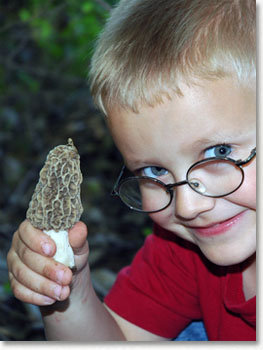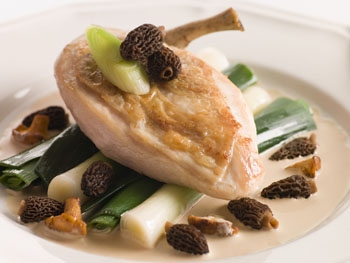 Spring time brings new growth and fair weather, tempting all but the most stubborn people outside. For those of you who have an urge to try something new, spring is also the ideal time to introduce your palate to some of Nature's most outstanding tastes. Spring time brings new growth and fair weather, tempting all but the most stubborn people outside. For those of you who have an urge to try something new, spring is also the ideal time to introduce your palate to some of Nature's most outstanding tastes.
If you've never attempted to forage for wild foods before, get yourself a plant identification guide before you begin. An experienced foraging partner is even better, but hard to find. Figure out which plants are likely to grow in your area and what you'd like to try, then gather your hunting supplies-a mesh backpack, sturdy shoes, walking stick, and good kitchen knife are all you really need for most foraging expeditions.
If you have no clue what you might like to try, consider these wild foods as the best place to start. Once you try them, you may never want to eat "normal" foods again!
Morel Mushrooms: Also known as "dry land fish," morels are a popular gourmet mushroom with a complex, savory taste and melt-in-your-mouth texture. They are usually found on east-facing hillsides, at the bases of elm and ash trees; they're also sometimes found in old apple orchards. They prefer damp, loose soils, and are sometimes found barely peeking out from under last year's leaves. Professional morel hunters sometimes place markers in areas where they have found a small patch of morels; if the mushrooms are small, hunters will often leave them alone for another week or so to allow them to grow larger.
Harvesting morels is simple-simply pinch or pick them off their stems. The stem is edible, as well, but many morel hunters prefer to leave part of the stem behind to encourage new growth the following year. Once you've gotten your mushrooms, put them in a bag with good air circulation, and take them home to cook.
Morels can be used the same way you would use any other mushroom, but many people like them served fried in real butter. Clean your mushrooms by wiping them with a damp cloth, or briefly soaking them in salted water before draining and wiping them dry. You can bread them the way you would button mushrooms, or fry them plain-either way is an awe-inspiring culinary experience. They're also excellent in cream based sauces and soups, and can be used to flavor beef roasts and stews.
Morels can also be dried for year-round use. Contact your local county extension agent for recommendations on the safest drying and preserving methods for your area.
Spring Beauty: These delicate white flowers with pink striped petals are commonly used as a lawn decoration in some areas; they can also be found growing wild in open woodland. They feature thick, grass-like leaves and rows of flowers that open at different times; the roots are oblong, potato-like tubers that vary in size from a tiny 1/4 inch bulb to almost two inches around. Thumbnail sized roots are most common.
Spring beauty earned the nickname "fairy spud" due to both the appearance of the root and the taste. The entire plant is edible. The roots may be boiled, fried, or roasted with meats; the leaves, flowers, and stems make interesting additions to raw salads and stir-fried dishes. Spring beauty is not recommended for drying or canning; freezing is also not recommended for preservation, due to the fact that the roots' taste and texture are negatively affected by the freezing process.
Dandelions: Yes, that annoying weed in your garden is actually a very good food plant! The young blooms have a sweet taste; the buds have an even stronger sweet taste. The leaves of young dandelion plants are good both raw and lightly cooked; they become progressively more bitter as they get older, however, so it's best to get your dandelions early.
Dandelion tea has been shown to have a diuretic effect, so if you have kidney or bladder problems, dandelion may not be the best food for you. However, if you've found yourself bloated from PMS, dandelion tea is a fast way to fit back into your skinny jeans!
Alliums' flowers: The flowering onions, garlic, leeks, etc all produce edible flowers. A garlic flower will taste like garlic; onion flowers taste like onions. However, there is a subtle difference in taste between the flower and the mature plant. You can use flowers from these plants as a garnish for meat dishes, or breaded and deep fried as an interesting, unique appetizer for a springtime party.
Wild violets: These pretty purple flowers have a sweet, delicate flavor and are easily identified by all but the youngest children. Eaten raw, the petals give a unique taste to salads, though some people find the taste objectionable when cooked. Violets are commonly used as decorations for cakes, iced drinks, and desserts.

Whatever wild plants you choose to add to your menu, be certain you've correctly identified them before you eat them. Never use plants that were found growing near roadways, as they have likely been sprayed with pesticides, and may contain toxins absorbed from car exhaust. Introduce wild edibles into your diet one at a time, in small amounts, to be certain you don't have any sensitivities to them. Once you've acclimated yourself to the plants of your choice, feel free to enjoy them as you would any other vegetable or mushroom, and continue to experiment with the wild edibles in your area. You may find your new favorite food growing in your own back yard!
|